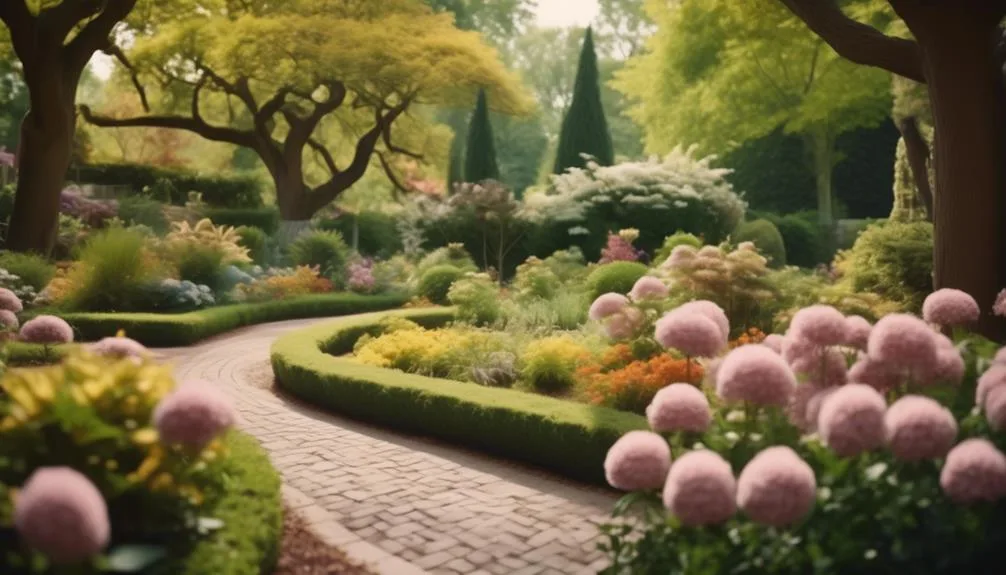Designing a garden with hickory trees is like creating a beautiful symphony, where each part works together in harmony. It involves careful planning to integrate the majestic trees into your garden, from choosing the best location for growth to selecting plants that complement their beauty.
This process aims to create a flourishing and visually appealing garden that showcases the unique characteristics of hickory trees.
Choosing the Right Location for Hickory Trees
When selecting the ideal location for planting hickory trees, consider choosing a spot with well-draining soil and ample sunlight to ensure their healthy growth and development. Hickory trees thrive in soil that's deep, moist, and well-drained, with a preference for slightly acidic to neutral pH levels. They require a minimum of six hours of direct sunlight daily to flourish.
When planting hickory trees, ensure the soil is loose and well-aerated to promote root growth. Prior to planting, it's advisable to water the area thoroughly, allowing the soil to settle before planting the tree. After planting, maintain regular watering, especially during the tree's establishment phase. Adequate watering is vital for the tree's initial growth and development.
Selecting Complementary Plants for a Hickory Garden
Selecting the right complementary plants for your hickory garden can enhance the overall appeal and ecosystem of your landscape, creating a harmonious and thriving environment for your hickory trees to flourish. When choosing plants to complement hickory trees, it's essential to consider their soil composition and sunlight requirements. Here are some suitable options for your hickory garden:
| Plant | Soil Composition | Sunlight Requirements |
|---|---|---|
| Wild Bergamot | Well-drained, loamy | Full sun to partial shade |
| Virginia Bluebells | Moist, rich | Partial to full shade |
| Coral Bells | Well-drained, fertile | Partial to full shade |
These plants not only thrive in similar soil compositions but also have varying sunlight requirements, allowing you to create a diverse and visually appealing garden while supporting the health of your hickory trees.
Designing With the Unique Characteristics of Hickory Trees
To maximize the visual impact and ecological benefits of your garden, embrace the unique characteristics of hickory trees in your design.
Understanding the soil composition and sunlight exposure that hickory trees prefer is crucial. Hickory trees thrive in well-drained, slightly acidic soil, so consider incorporating plants that also thrive in this type of environment.
Additionally, hickory trees prefer full sunlight, so be sure to design your garden in a way that allows these trees to receive ample light.
When selecting companion plants, consider those that can coexist with hickory trees' soil preferences and don't create too much shade.
Maintaining a Healthy Garden With Hickory Trees
Embracing the unique characteristics of hickory trees in your garden design also involves maintaining a healthy ecosystem that supports these trees' vitality and longevity. To ensure a thriving garden with hickory trees, consider the following:
- Pruning Techniques:
Regularly prune your hickory trees to remove dead or diseased branches, maintain a balanced canopy, and encourage healthy growth. Proper pruning can also help improve air circulation and sunlight penetration, which are essential for the overall health of the trees.
- Soil Management:
Hickory trees thrive in well-drained, slightly acidic soil. Conduct regular soil tests to monitor pH levels and nutrient content. Amend the soil as needed to provide optimal growing conditions for hickory trees, ensuring they receive the necessary nutrients for robust growth and development.
- Mulching:
Apply a layer of organic mulch around the base of hickory trees to help retain moisture, regulate soil temperature, and suppress weed growth. This will also contribute to the overall health and vigor of the trees.
Enhancing the Aesthetics of a Garden With Hickory Trees
Enhance the visual appeal of your garden by incorporating the majestic beauty of hickory trees into your landscape design. When incorporating hickory trees into your garden landscaping, consider their impressive height and wide canopy, which can provide shade and create a focal point.
To enhance the aesthetics, plant hickory trees strategically to frame specific areas or pathways, drawing attention to the natural beauty of your garden. Consider the foliage colors of different hickory tree species to add visual interest and variety to your landscape.
Additionally, hickory tree care is essential to maintain their health and beauty. Regular pruning to shape the tree and remove dead branches can enhance their appearance and promote healthy growth.
Conclusion
Incorporating hickory trees into your garden design can yield a thriving and visually appealing outdoor space. By thoughtfully selecting the right location and complementary plants, while embracing the unique characteristics of hickory trees, you can create a lasting, natural beauty.
With ongoing care, your hickory garden will flourish, offering a serene and inviting haven for years to come.
Mark Hoffman is a dedicated arborist and tree care specialist with over a decade of experience. His love for trees began when he visited Yosemite National Park as a teenager and was awestruck by the giant sequoias. Mark pursued his passion by studying forestry at Michigan Technological University, where he earned a Bachelor of Science degree.
Since then, he has worked tirelessly in the field of arboriculture, helping to preserve and protect trees in his community. His expertise and dedication have made him a respected leader in the industry and a valuable resource for anyone seeking advice on tree care.
